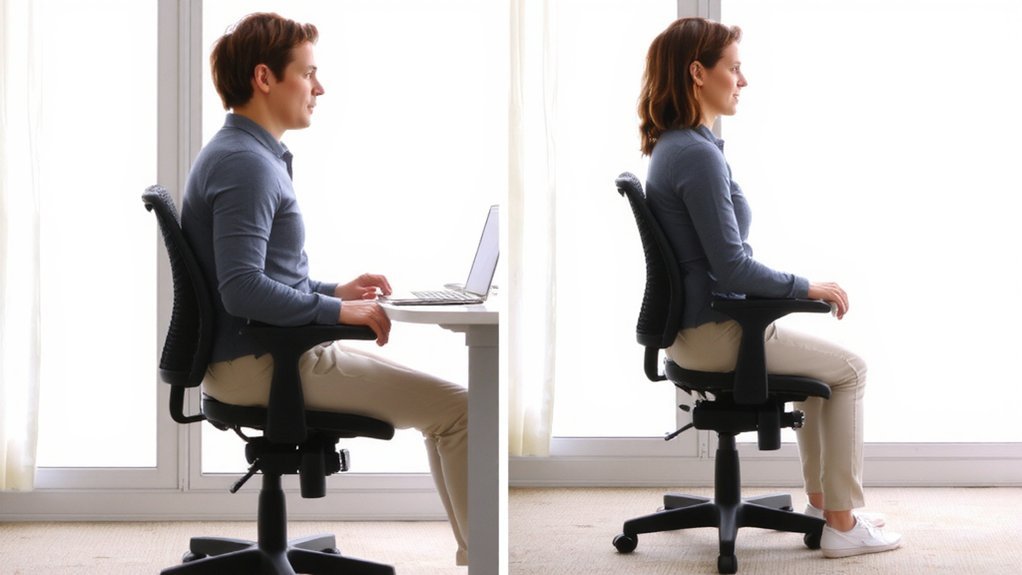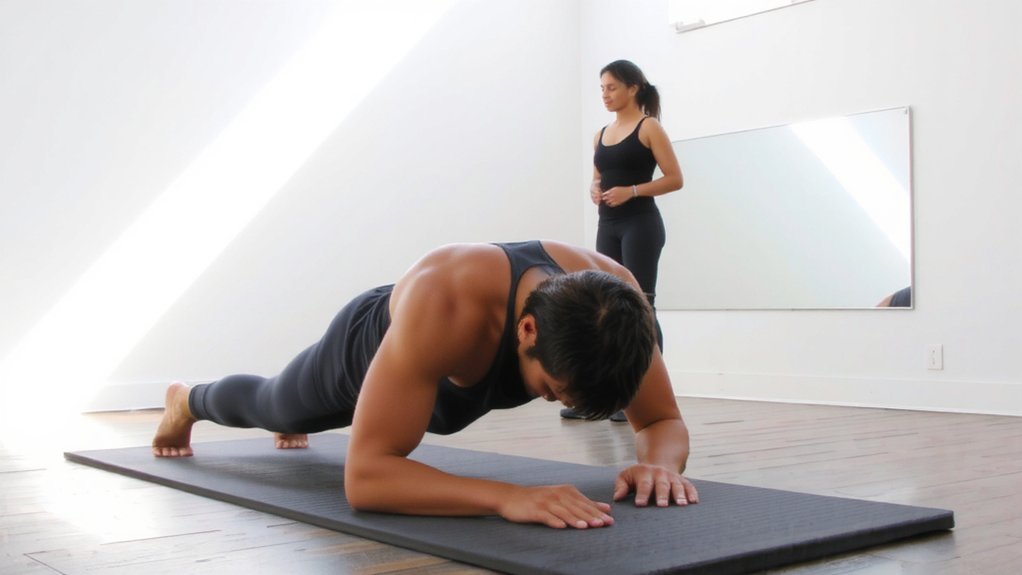You can improve posture with small, consistent changes that cut pain and boost how you feel. Start by learning standing and sitting alignment, strengthening core and back muscles, and adjusting your workstation. It’s practical and achievable, and next you’ll get simple, step‑by‑step actions and quick exercises to start right away.
Why Good Posture Matters

Because your spine supports everything you do, good posture keeps your body aligned, reduces strain on muscles and joints, and helps prevent pain and injury.
When you maintain proper alignment, your organs sit where they should, letting breathing and digestion work more efficiently. Your muscles don’t overcompensate, so you expend less energy and tire slower during daily tasks.
Clear alignment also lowers wear on joints, decreasing risk of chronic problems like osteoarthritis and nerve compression. You move with better balance and coordination, which cuts fall and injury risk.
Good posture improves how you present yourself, boosting confidence and how others perceive you. Investing attention in posture now pays off with less discomfort, better function, and greater long-term mobility, and helps you stay active longer.
How to Stand Properly

When you stand correctly, you reduce strain and improve balance by keeping your ears over your shoulders, your shoulders over your hips, and your hips over your ankles.
Stand with feet hip-width apart, weight evenly distributed between both feet and slightly toward the balls of your feet. Soften your knees—don’t lock them.
Tuck your pelvis to maintain a neutral spine and gently engage your core so your lower back isn’t overarched.
Roll your shoulders down and back, open your chest, and keep your chin level to avoid jutting your head forward.
Wear supportive shoes and avoid prolonged static standing—shift your weight or take short walks every 30–60 minutes.
Use quick posture checks and the wall test to reinforce proper alignment throughout the day. Repeat.
Proper Sitting Techniques

If you sit for long periods, set up your chair and workspace so your hips sit slightly higher than your knees, your feet rest flat on the floor, and your knees are roughly level with your hips.
Sit well back so your lower back contacts the lumbar support; add a small cushion if needed.
Keep your shoulders relaxed and down, and pull your shoulder blades gently toward each other.
Rest your forearms on armrests or the desk with elbows near a 90-degree angle to reduce shoulder strain.
Keep your weight evenly on both sit bones and avoid crossing your legs.
Adjust seat depth so there’s two to three fingers’ space behind your knees.
Move or stand briefly every 30–60 minutes to prevent stiffness.
Neck and Chin Tuck Strategies

While you maintain the seated setup described earlier, chin tucks help pull your head back over your shoulders and unload strained neck muscles.
Perform slow, controlled tucks: slide your chin straight back without tilting, hold two to five seconds, then relax. Do 8 to 12 repetitions, two to three times daily.
Pair tucks with gentle neck rotations and side bends to improve mobility; move only to the point of mild tension.
Use a mirror or a fingertip against your chin for feedback so you avoid jutting forward. If you feel pain, reduce range or stop and consult a professional.
Gradually progress by increasing hold time or adding light resistance with a band.
Consistency matters; brief, frequent practice beats occasional long sessions for better posture.
Core Strengthening Exercises

Strengthening your core stabilizes the spine, supports upright posture, and lessens strain on your neck and shoulders.
You should train deep and superficial core muscles with controlled, functional moves.
Start with front planks and side planks, holding 20 to 60 seconds; progress by increasing time or adding leg lifts.
Use dead bugs and bird-dogs to reinforce coordination and neutral spine control—perform eight to fifteen slow, controlled reps per side.
Add glute bridges to integrate hip extension and pelvic stability.
Focus on breath: inhale to prepare, exhale while engaging the transverse abdominis.
Practice three sessions weekly, two to four sets per exercise.
Prioritize quality over quantity, maintain neutral alignment, and stop if you feel sharp pain—consult a professional for concerns.
You’ll see gradual posture improvements.
Stretches to Release Tight Muscles
After working your core, you’ll want to release tight muscles that keep you out of alignment.
Focus on chest openers: stand in a doorway, place forearms on the frame, gently lean forward until you feel a stretch across your pectorals and front shoulders. Do 30–45 seconds, breathing deeply.
For tight hip flexors, kneel on one knee, tuck your pelvis, and shift forward until you feel a front-hip stretch; hold 30–45 seconds per side.
Sit or stand for hamstring relief: hinge at the hips with a straight spine and reach toward your shins, keeping a soft knee; maintain 30 seconds.
Finish with glute stretches like figure-four on your back for 30 seconds each.
Repeat daily or after workouts to restore balance and reduce chronic pain.
Quick Posture Exercises You Can Do Daily
Try a few short, targeted moves you can do several times a day to reset your alignment and reduce tension—no equipment needed.
Stand tall, tuck your chin slightly, and roll your shoulders back and down ten times to open the chest.
Do wall angels: stand with your back to a wall, slide arms up and down while keeping contact, ten reps to improve scapular mobility.
Perform seated pelvic tilts to find neutral spine: five slow tilts, holding neutral for 10 seconds.
Practice single-leg stands for balance and hip stability—stand on one foot for 30 seconds, switch sides.
Finish with gentle thoracic rotations: seated or standing, rotate upper torso slowly ten times each direction.
Repeat these brief routines three times daily throughout your day regularly.
Ergonomic Tips for Workstations
When you set up your workstation, align everything so your body stays neutral: adjust your chair so your feet sit flat and knees are at or slightly below hip level, raise your monitor so the top third of the screen is at eye level, and position your keyboard and mouse close enough that your elbows stay near your sides with forearms roughly parallel to the floor.
Use a chair with adjustable lumbar support; your spine should follow its natural curve.
Keep used items within easy reach. Use a document holder at monitor height. Reduce glare with adjustable lighting and position screens perpendicular to windows.
If you use a laptop, don’t use its screen and keyboard—add a riser. Alternate sitting and standing every 30–60 minutes.
How to Break Bad Posture Habits
Good ergonomics make posture easier, but old habits will undo that progress unless you actively replace them. Start by noticing when you slump, crane your neck, or round your shoulders; logging triggers helps you spot patterns.
Use discreet cues — a phone alert, a wristband, or a sticky note — to prompt an immediate correction: sit tall, retract your shoulder blades, align your head. Practice short micro-adjustments throughout the day so proper alignment becomes reflexive.
Combine brief mobility breaks to release tight chest and hip flexors that reinforce poor positions. When you catch yourself slipping, reset calmly instead of tensing.
Expect setbacks; respond with gentle repetition and the same corrective cues until the new response outweighs the old one. Celebrate small wins — you’ll keep going strong.
Creating a Sustainable Posture Routine
Consistently create a short, practical routine you can actually stick to so posture becomes automatic.
Pick three to five daily actions: a morning alignment check, midday movement breaks, targeted stretches, and a short strengthening exercise.
Set reminders on your phone and tie habits to cues like sitting at your desk or finishing a meal.
Track progress in a simple log or app and adjust intensity weekly.
Prioritize enjoyment and realism—if an exercise feels tedious, swap it for one you’ll do.
Use ergonomic supports only as aids while you build muscle control.
Gradually increase duration or reps as your body adapts.
Review your routine monthly and make small changes to keep it effective and sustainable.
Celebrate small wins to reinforce the habit and stay motivated.
Conclusion
You’ve learned why posture matters and how to stand, sit, and move with better alignment. Use chin tucks, core and glute work, and quick daily stretches to reinforce good form. Set up your workstation ergonomically, use cues or timers, and swap habits gradually so changes stick. Review progress, celebrate small wins, and keep routines simple — that consistency will make better posture part of your everyday life. You’ll feel stronger, more confident, and less strained daily.